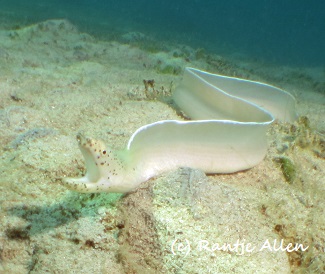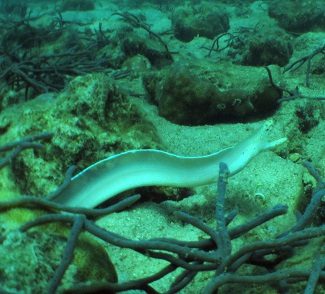Loading content - please wait...
White ribbon eel glides in Gorontalo
White ribbon eel glides across the sandy bottom in shallow water. It undulates in effortless motions.
An Unexpected Sighting
During daylight hours, white ribbon eels usually stay hidden in their sandy dens. They live in shallow lagoons, preferring areas with white sand. At night, they emerge in search of food. They prefer to eat small crustaceans and molluscs. Sometimes, they will eat nudibranchs.

At other times
, they will move from one den to another. This means they will swim across the sandy bottom. One day, Miguel’s Diving staff observed a White ribbon eel doing just that. However, this one did not move quickly from one hole to another. It spent fifteen minutes swimming across the bottom. Occasionally, it stuck its head into goby holes. Perhaps it was searching for a shrimp to eat.Once, it swam underneath some cloth lost by a fisherman. The cloth was half buried in the sand. Soon, the White ribbon eel emerged from the other side. After crossing back and forth, it finally disappeared head first into a hole.
Elegance in Motion
This ribbon eel has a pale body color. Its dorsal fin is continuous and edged in brilliant white. Its face is peppered with small spots. When swimming, its motion in indeed like a sensuous ribbon.
The Truly Unique White Ribbon Eel
White ribbon eels belong to its own genus of which it is the only species. That means its morphology is truly unique. As with other eels, it does not have scales. Instead, slime covers its body. This mucous coating allows it to enter and exist holes in sand and gravel without getting scratches. Also, the slime repels parasites.
The eyesight of this unique eel is not as good as its sense of smell. That sense is well developed. Moreover, it has not two nostrils but four. The first pair lie on the tip of its nose. The second pair are barely visible and lie level with its eyes. Its sense of smell leads the White ribbon eel to its prey. In fact, during the long interval with our dive staff, the ribbon eel totally ignored the diver and camera. Nothing good to eat there!

As with many eels, the branchial openings are small holes. They are found behind the head, one on each side.
The maximum length of this beautiful ribbon eel is about one meter. However, most measure between fifty and eighty centimeters in length.
Its Scientific Name
Pseudechidna brummeri is the official name of the White Ribbon eel. Its genus name consists of two Greek words. Pseudes means false and echidna means viper. This name is meant to describe the pointed feature of its long snout.
Pieter Bleeker was a Dutch doctor who lived in Indonesia for eighteen years. During that time, he collected over twelve thousand specimens of marine life. He published extensive studies in his two work classic Atlas Ichthyologique des Indes Orientales Néêrlandaises. One of the species he discovered and named was the White ribbon eel, Pseudechidna brummeri. The species name honors Lieutenant Medical Colonel Brummer. Brummer was a colleague
, friend and fellow collector.For your chance to dive with beautiful marine life, please make your dive reservations and perhaps you will sight a ribbon eel.





